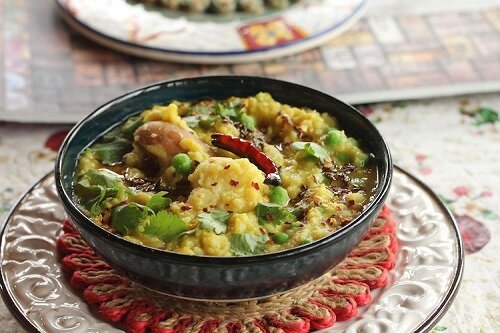A Bold Take on Wine Pairing with Indian Food
Butter Chicken. Photo credits to Rinku Bhattacharya
The first order of business when faced with pairing Indian food with wine is to move right past the gewurztraminer. Actually, better yet, save the gewurztraminer for dessert. The sheer diversity of Indian cuisine can make wine pairing an adventure or a challenge depending on your perspective but relying on sweet wines in hope of balancing strong flavors is rarely the most interesting or satisfying match. Because Indian food is not designed to be paired with wines doesn’t mean it doesn’t pair well with wines or that one style of wine is better than any others.
Diversity of flavors
Khichuri. Photo credits to Rinku Bhattacharya
Patrick Miner the former wine director at Taj Campton Place a Michelin starred Indian restaurant in San Francisco aptly says, “The first and biggest misconception is that there is some sort of standard characteristic shared by all Indian food. Indian food encompasses such a vast diversity of flavors, ingredients, cooking techniques, and influences that I find it is rarely beneficial to think about Indian food in general.” Flavors within the Indian culinary universe can range from the robustly spiced flavors of Southern Indian, including citrusy curry leaves, black peppercorns, notes of ginger often harmonized with nutty and creamy coconut milk. Western Indian cuisine keeps the coconut but mellows the flavors, adding lots of grains, peanuts into the mix. Food from North India is known for fragrant spices such are garam masala, a fragrant spice blend with notes of cardamom, cinnamon and cloves, nuts, dried fruits, and lush tomato rich sauces. In Eastern India coconut makes a reappearance often accompanied with pungent and sharp notes of mustard and a touch of sweetness.
As an experienced Indian culinary instructor and cookbook author, I feel that with anything complex, a lot depends on understanding the nuances of the dish, and looking at just the proteins or even a single dish is not enough. Consider the much loved Chicken Tikka Masala, the flavor profile usually will include garam masala a fragrant spice blend, along with tomatoes that are balanced out with the richness of cream. But just looking at that one dish may not be enough since a well-assembled Indian meal will often incorporate a diversity of flavors and dishes. Think of the whole meal and its texture, levels of richness, and prominent flavors.
Red wines vs white wines
Bengali Lamb. Photo credits to Rinku Bhattacharya
Sumita Sarma, a wine communications consultant, drinks writer, and specialist, the founder of Sumilier, a wine consultancy says, “The most important point to remember is to match your wine with the level of tanginess and spices of your food. Any style of wine can pair well with Indian cuisine if you learn the art of distinguishing and breaking down acidity and spices in your food and match them to the wine selected. The tangier your food is, the more acidity you can aim for in your wine. While the more spice in your food, the more mellow and integrated spiced notes in the wine you should look for.” Instead of Gewurztraminer, she suggests chenin blanc and riesling. But don’t shy away from red wines. Her pick is a food-friendly red to pair with Indian food is pinot noir.
I am personally partial to New World wines as a general rule of thumb when pairing with Indian food. Some of my favorites include South African pinotage, Chilean pinot noirs, and sauvignon blancs from New Zealand. These wines generally have the right acidity to hold up to the bolder flavors on the Indian table. Rather than simply extinguishing the heat of spicy food, “Wine pairing is about enhancing the flavors of both the food and the wine” says Maneet Chauhan, James Beard award-winning chef. She suggests avoiding lighter wines including carmenere, which has light tannins, and petite sirah, which doesn't have enough body to hold up to Indian flavors. Her menu at her Nashville based restaurant Chauhan Ale & Masala House showcases a variety of bold reds such as malbec from Argentina and a Napa Valley zinfandel, complemented with cooler climate whites and roses from France and Austria.
Dessert pairing
Indian desserts tend to be rich and fairly complex and well suited to pair with subtly sweet wines rather than excessively sweet dessert wines. And so we return to gewurztraminer, or even something like chenin blanc as a possibility depending upon the level of sweetness in the dessert.



